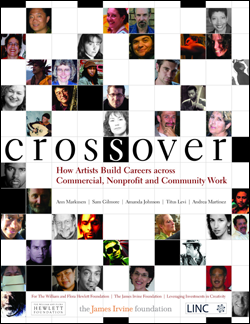Crossover: How Artists Build Careers across Commercial, Nonprofit and Community Work
104 pages, October 2006. Humphrey School of Public Affairs, 130 Humphrey School, 301 19th Ave. S, Minneapolis, MN 55455. http://www.hhh.umn.edu
Download:
![]() Crossover: How Artists Build Careers across Commercial, Nonprofit and Community Work (5Mb)
Crossover: How Artists Build Careers across Commercial, Nonprofit and Community Work (5Mb)
In this study, the authors delineate three sectors of artist work—commercial, nonprofit, and community—and address how they are organized, including the motivations and conventions that govern each sector. The report pulls together a number of hypotheses about how artists navigate these sectoral divides. To reach artists, the authors use a web-based survey, soliciting responses by working with dozens of arts and cultural organizations in the San Francisco Bay and Los Angeles metropolitan areas, which host the two largest artistic populations in California and rank first and third in the nation in density of artists in the workforce. Particular attention is paid to part-time, ethnic and community-based artists who the authors argue are often left out of surveys and undercounted in the Census. Also interviewed are more than fifty artists from a diverse mix of disciplines, age, race, ethnicity, immigrant status, and income about their own experiences at crossover.
The report finds that artists move among sectors far more fluidly than previously believed and, if money were not an issue, most would cross over even more than they presently do. They report that each sector provides distinctive channels and support for artistic development. The study findings have far-reaching implications for how leaders in each sector might acknowledge the contributions of the others and cooperate to encourage greater cross-fertilization and the report attempts to articulate some productive avenues for change.

